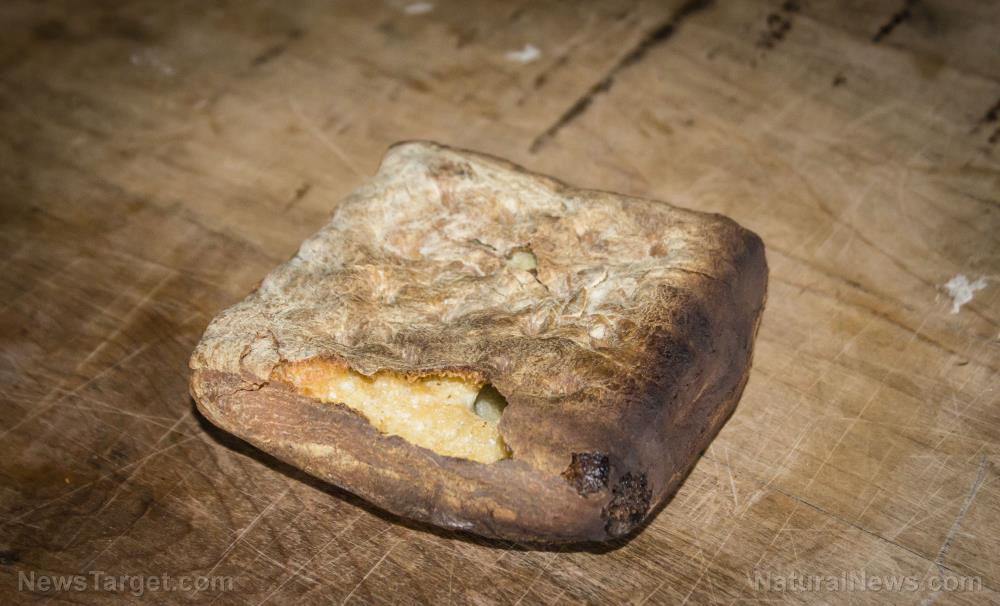Flurry of active volcanoes will cause global COOLING and crop failures… global financial and political systems on the verge of catastrophe
12/15/2021 / By Mike Adams

Very few people are tracking this, but the number of active volcanoes that are right now spewing particulate matter into the upper atmosphere is extraordinary. This page on VolcanoDiscovery.com lists volcanoes that are active right now across the globe, and it numbers in the dozens.
The La Palma volcano (Cumbre Vieja) has been so large that the size of the island on which it sits has expanded by 43 hectares since it began erupting. During this, the volcano has ejected large quantities of particulate matter into the atmosphere.
According to this Smithsonian / USGS weekly volcanic activity report, four new volcanoes just began erupting from Dec 1 to Dec 7 of this year, with over a dozen active volcanoes listed across nearly every continent. The Ring of Fire is heating up…
The La Palma volcano has been quiet for two days or so, leading many observers to believe the vent has become blocked. Unless the pressure underneath the vent is somehow diverted, this may lead to a build up of extreme pressure until a catastrophic blow-off occurs. The larger the eruption, the more particulate matter is ejected into the atmosphere.
For example, as reported by Electroverse.net about a volcanic explosion earlier this year:
Sumatra’s incredibly active Sinabung Volcano has exploded in spectacular fashion again today, March 2, sending volcanic ash high into the atmosphere.
The Volcanic Ash Advisory Center (VAAC) Darwin is warning of a thick ash plume rising to 40,000 feet (12.2 km).
Particulates ejected to altitudes above 32,800 feet (10 km) –and into the stratosphere– have a direct cooling effect on the planet.
These large eruptions that spew particular matter into the atmosphere are called “ash plumes,” and NASA monitors ash plumes across the globe using Moderate Resolution Imaging Spectroradiometer (MODIS) imagery.
Ash plumes block sunlight from reaching the vegetation layer on the surface of the Earth
The more ash plumes take place, the more sunlight gets blocked from reaching the surface of the Earth. This causes several effects, notably:
1) Global cooling of the planet.
2) Reduced solar energy reaching food crops and other types of vegetation.
The April 5, 1815 eruption of Mount Tambora, for example, ejected so much material into the atmosphere that the summer of 1816 became known as, “the year without a summer.” The entire planet was significantly colder, food crops failed and people starved to death all across the world. As explained by the UCAR Center for Science Education website:
Mount Tambora ejected so much ash and aerosols into the atmosphere that the sky darkened and the Sun was blocked from view.
But the smaller particles spewed by the volcano were light enough to spread through the atmosphere over the following months and had a worldwide effect on climate. They made their way into the stratosphere, where they could distribute around the world more easily. Earth’s average global temperature dropped three degrees Celsius.
The Year Without a Summer had many impacts in Europe and North America. Crops were killed – either by frost or a lack of sunshine. This caused food to be scarce, and caused farmers who were able to grow crops to fear that they would be robbed. The lack of successful crops that summer made the food which was grown more valuable, and the price of food climbed.
A source has told us that if the La Palma volcano erupts with sufficient force, it would not merely threaten the US East Coast with a tsunami, but that it would also cause a global cooling effect of up to 2 degrees Celsius, lasting 1-2 years. We have not been able to confirm this estimate with any academic geologist, but given that the Mount Tambora eruption caused a 3 degree drop in global temperatures, this equation is simply a matter of how much particular matter gets ejected into the atmosphere and what altitude it achieves.
A 2 degree drop in global average temperatures would collapse food yields worldwide while also hampering solar energy production in Germany and other European nations that rely heavily on solar panels. At the same time, Germany is shutting down the Nordstream 2 gas pipeline from Russia, worsening an already extreme shortage of hydrocarbons for fertilizer production across the European continent, guaranteeing food crop shortages and extreme food inflation throughout 2022. (Learn about the Haber equation and how hydrocarbons are used to create ammonia – NH3 – for fertilizers.)
It looks like a perfect storm of global famine is rapidly approaching, and if the La Palma volcano blows with sufficient force, it could be a real-life doomsday scenario for many citizens across the world. Conventional geologists, however, say that the La Palma eruption may be over and there’s nothing more to see there. Let us all hope they are correct. Keep an eye on the island just to be sure.
The financial eruption and final blow-off
At the same time, a financial eruption and final blow-off appears to be well under way in both the conventional investment markets as well as crypto markets. In the world of conventional finance, the US Fed just announced today an accelerated tapering of its quantitative easing, doubling its tapering to a $30 billion monthly reduction going into effect in January, followed by three estimated rate hikes in 2022 that will slam the brakes on the money leverage machine that has pushed markets to record highs.
This means the final blow-off of mad market rises backed by runaway money printing may be about to come to an end. Given that the Fed has been buying up much of the US debt (Treasuries) and market instruments (bonds), any reduction in the Fed’s purchases could be catastrophic for the ever-expanding bubble.
In the crypto universe, word is rapidly spreading that so-called “stablecoins” aren’t backed by much of anything and that the crypto ecosystem suffers from the same money printing madness as the Federal Reserve. By some estimates, around 90% of the current market capitalization of Bitcoin is based on leveraged trading bots and digital fiat currency money printing backed by nothing.
A class action lawsuit has been filed against Tether, claiming the stablecoin company deceived customers about its deposits, and that lawsuit states that Tether only holds actual dollar deposits equal to 4% of what its circulating stablecoins should demand. (Read it here.) If this apparent crypto leveraging begins to unwind, it will do so without any of the automatic circuit breakers or pauses that characterize conventional financial markets, and a true “crypto bloodbath” could be the end result. This is also called a “crypto reset.” Watch my recent interview with John Perez here:
Also check out the entire “Crypto Conspiracy” series by David Morgan at:
https://www.brighteon.com/channels/themorganreport
These two things — volcanoes and crypto bubbles — are intertwined, as the crypto universe is largely based on faith and optimism rather than solid financial backing and well-conceived self-regulation. As a result, any destabilizing world event raises the risk perception in all bubbles, including Wall Street bubbles and crypto bubbles.
Stated another way, the La Palma volcano exploding — or Russia engaging in kinetic conflict over Ukraine — could initiate a wave of panic that would see people dumping speculative assets and seeking out gold, silver, land or other hard assets that can’t simply vanish overnight. (During times of fear, people move to hard assets.) China could also move on Taiwan, or there could be a cyber war false flag attack on the financial infrastructure of the world. That exact scenario is being war gamed right now by Israel and ten other nations. These “simulations” often go live, it turns out.
By the way, the gold:silver price ratio has just hit 80:1. This almost never happens. Those who know what this means are currently buying all the silver they can take on. Effectively, silver is extremely discounted and it’s very nearly a once-in-a-lifetime buying opportunity on silver right now.
Prepare for severe food inflation and food shortages in 2022
Meanwhile, the financial markets in the USA are still trying to recover from the shocking news that Producer Price Index (PPI), a measure of real inflation, has reached 9.6% year over year. In reality, of course, actual inflation is over 20%, but this is the first time the US government itself has admitted to any inflation number that approaches double digits.
The Fed is now playing a catch-up game, trying to taper its money printing machine and ease into rate hikes, but it’s too little, too late. 2022 is going to see food inflation continue to spiral out of control, likely seeing 25% – 40% inflation in many popular food items, ultimately devastating low-income consumers who are unable to keep up with the price increases.
What this means is that 2022 will see incredible consumer frustration over inflation and food prices, and this will almost certainly lead to a wipeout of Democrats in the 2022 mid-term elections if they are allowed to take place. Hence, the Democrats and the Marxist deep state currently in power will try everything to cancel the elections. This means they will have to create endless crises and cancel the elections if they can pull it off. I will cover that in more detail in tomorrow’s podcast.
For today, I focus on everything mentioned here, plus additional details on Russia, the bailing out of hedge funds with central bank money, the lawsuit against Tether and more:
Brighteon.com/c15dfb9d-87be-4dc4-be6c-c4d30ccb4fb0
Don’t miss tomorrow’s podcast on the coming events in 2022. See it at the HR Report channel on Brighteon:
https://www.brighteon.com/channels/hrreport
Tagged Under: chaos, climate change, climate science, Collapse, crop failures, economy, eruption, famine, food crops, food supply, Global Cooling, harvest, inflation, interest rates, Money Printing, risk, starvation, volcanoes
RECENT NEWS & ARTICLES
EmergencyFood.News is a fact-based public education website published by Emergency Food News Features, LLC.
All content copyright © 2018 by Emergency Food News Features, LLC.
Contact Us with Tips or Corrections
All trademarks, registered trademarks and servicemarks mentioned on this site are the property of their respective owners.




















